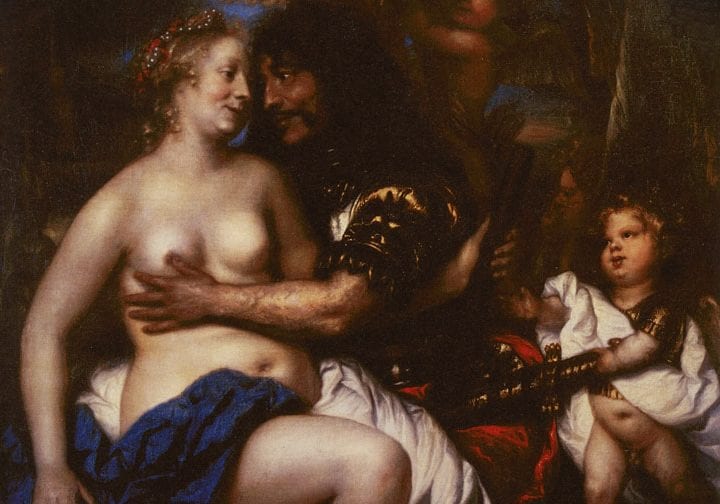This essay reconsiders Jan Lievens’s Mars and Venus as a commission by the new Electress of Brandenburg, Louise Henriette of Orange-Nassau (1627–1667), and frames it within the collecting taste established by her parents at the court in The Hague. This contextualization reconciles the painting’s identification as allegory, history and portrait historié, and illuminates Lievens’s visual sources.
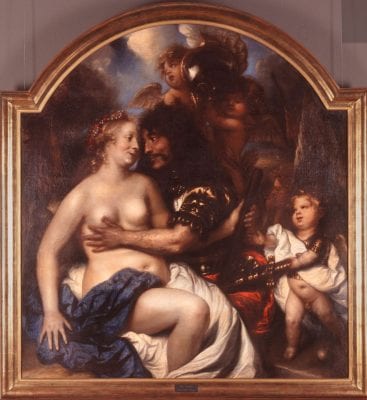
In his 1932 catalogue raisonné of the work of Jan Lievens (1607–1674), Hans Schneider reacted strongly to the suggestion that Lievens’s Mars and Venus (fig. 1) of 1653 contained portraits of the painting’s first owners, the Brandenburg Elector Friedrich Wilhelm (1620–1688) and his consort Louise Henriette of Orange-Nassau (1627–1667). Not only did Schneider see no similarities between the physiognomies in the painting and known portraits of the royal couple, but he also objected to the proposal that the Electress would have had herself represented in such a “free” manner.1
Indeed, the picture’s sensual nature reveals itself upon first glance. The painting captures the gods outdoors in an intimate moment: the nude Venus looks dreamily at her armored paramour, who leans in and reaches across her torso to fondle her breast. Mars is so enchanted by the charms of Venus that he disregards the confiscation of his military baton–which emerges from his lap in an overtly phallic reference–by Venus and the removal of his sword and plumed helmet by three putti. The putto at the lower right coaxes Mars’s weapon from its sheath in a movement that exposes his cherubic genitalia below his miniature version of Mars’s fringed cuirass. Mars’s gaze practically sears the surface of the canvas, and Venus’s reciprocation enhances the intensity of their interaction. Above all, luminous female flesh dominates the life-size scene.
The overt eroticism of the scene has confounded viewers’ abilities to agree upon a single interpretation. The painting has endured a surprising range of classifications–history, portrait, allegory of marriage–since it was first documented in the collections of the royal couple in 1699.2 The desire to treat the picture as a historiated portrait, in particular, has emerged intermittently in the literature since 1816,3 yet Schneider’s protests have loomed larger over modern scholarship on the picture. A reconsideration of the painting’s function, patronage, and site of display could establish a viewing context in which a reading of the painting as a portrait historié would not only be tolerated but prized. The foundation for such an interpretation, I believe, lies in its multifaceted connection to the Orange court in The Hague.
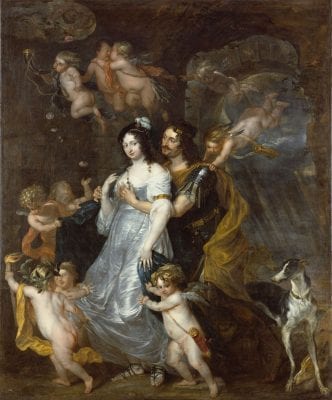
Several portraits point to Mars and Venus as bearers of the features of Friedrich Wilhelm and Louise Henriette. While comparisons have been made with the 1646 depiction of the couple as Aeneas and Dido (fig. 2) by Thomas Willeboirts Bosschaert (1614–1654),4 other portraits further support this connection, such as the 1650 Allegory of the Marriage of Louise Henriette and the Great Elector of Brandenburg (fig. 3) by Gerard van Honthorst (1590–1656), the ca. 1655 Allegory of the Founding of Oranienburg (fig. 4) by Willem van Honthorst (1594–1666), and the ca. 1666 Elector Friedrich Wilhelm and His Family (fig. 5) by Jan Mytens (ca. 1614–1670). In spite of the personal stylistic interpretation of each artist, all of these paintings reveal Friedrich Wilhelm’s beaked nose, full chin, deep-set brown eyes, and flowing locks and mustache. Similarly, Louise Henriette’s brownish-gray eyes, delicately pointed yet long nose, full cheekbones, and button lips are consistent features of these portraits. The transformation of Louise Henriette’s dark hair into golden tresses likely reflects traditional depictions of Venus, as seen in the Pardo Venus (ca. 1540; Musée du Louvre, Paris) by Titian (ca. 1488–1576) and the Horrors of War (1637–38; Galleria Pitti, Florence) by Peter Paul Rubens (1577–1640), for example–which Lievens would have seen during his time abroad–and as described in literary sources like Homer (ca. 8th century BCE), who is cited in Wtlegginge op den Metamorphosis by Karel van Mander (1548–1606).5 The linchpin for recognition of the portraits in Lievens’s painting, however, is the unconventional physiognomy of Mars, and specifically the highlight along the ridge of Mars’s nose that defines the aquiline contour so visible in Gerard van Honthorst’s portrait (fig. 6).
The couple’s interest in role-playing surely stemmed from Louise Henriette’s parents, Stadholder Frederik Hendrik of Orange-Nassau (1584–1647) and Amalia van Solms-Braunfels (1602–1675), who commissioned Bosschaert’s double portrait of 1646. As has been observed, the portrait historié had come to be appreciated at their court in The Hague to an unprecedented degree.6 Diana seems to have been a popular choice for Amalia and her relations in the 1630s and 1640s,7 as Gerard van Honthorst painted the Stadholder’s wife, her sister Louise Christina (1606–1669), and her grand-nieces as the virgin goddess.8 Amalia also had herself painted as Flora around 1629 and as Esther in 1633,9 and other female members of the extended Orange-Nassau family had themselves represented in these guises, as well as that of Minerva.10 Interestingly, in the very same year that Louise Henriette was married in The Hague, her cousin by marriage Queen Elizabeth of Bohemia (1596–1662) had herself portrayed as Venus by Honthorst.11 There were even precedents for mythological double portraits, as evidenced by Honthorst’s 1633 painting depicting Amalia and her niece, Charlotte de Trémouille (1599–1664), as Diana and a nymph.12
These examples and the observations of several scholars indicate that portrait historié at the court in The Hague was gendered in distinctly feminine terms,13 which is supported by the reversal of traditional hierarchies in Lievens’s double portrait. Notably, Lievens places the princess of Orange in the dexter position and relegates her husband to the sinister location, thereby inverting common practices of depicting the genders in Northern portraiture.14 As Sarah Crawford-Parker has argued about Bosschaert’s painting (fig. 2),15 this upending of portrait conventions situates Louise Henriette in the privileged position and thereby calls attention to her. David R. Smith would contend that the Electress’s prominence is merely a function of the narrative in which the couple participates.16 In the paintings by Lievens and Bosschaert, the female characters that Louise Henriette assumes do make their male counterparts submit to them, thereby asserting their dominance and justifying her situation in the dexter spot. Interestingly, this inversion is also seen in the nonnarrative portraits by the Honthorst brothers (fig. 3 and fig. 4), the former commissioned by Louise Henriette’s mother and the latter executed for Louise Henriette herself. The inversion of figures in these two paintings, which were displayed in spaces erected by female members of the house of Orange, may serve to emphasize Louise Henriette’s position as the daughter of a prince, and therefore of higher noble status than her husband the duke.17
Given the arrangement of the couple and the painting’s earliest documented location,18 Louise Henriette almost certainly commissioned this picture from Lievens. The 1699 inventory records the Mars and Venus as hanging in an unidentified room in Schloß Oranienburg. Friedrich Wilhelm described the palace as having been designed according to the Electress’s tastes and means, which is evident in the “LC” monogram (for “Louise Churvorstin”) visible throughout the building. On September 27, 1650, Friedrich Wilhelm presented the entire municipality of Bützow to his wife–perhaps because of the terrain’s similarity to parts of Holland–and she quickly decided to renovate its dilapidated hunting lodge.19 By 1652, she had renamed her architectural project “Oranienburg.” The palace was reconstructed by the Dutch-trained architect Johann Gregor Memhardt (d. ca. 1678), and, as suggested by its name, it directly reflected the built environments that the Electress knew from her youth in The Hague. The plan emulated that of Huis ter Nieuburg, the modest summer residence erected by Louise Henriette’s father, Frederik Hendrik, in Rijswijk outside of The Hague in the 1630s.20 With its large entry hall and grand staircase flanked by symmetrical chambers, Oranienburg’s original plan extended from a corps-de-logis outward to two square pavilions via galleries. The exterior also reflected the classicizing style of Jacob van Campen (1595–1657) at Ter Nieuburg through the prominent pediment that rose in front of a hipped roof, the accentuated center bays, the pronounced window frames, and the formal symmetry. The interior arrangement further demonstrated an affinity for the layout of Orange palaces.21 The west wing contained the portrait gallery fundamental to many European royal residences, and it would also come to house a rare porcelain cabinet following the pioneering displays set up by Louise Henriette’s mother, Amalia van Solms, at palaces in The Hague.22 Further echoes of Ter Nieuburg would have been visible in Oranienburg’s main hall, which featured a ceiling painting of the four seasons accompanied by “Oriental” figures and musicians behind a golden trompe l’oeil balustrade.23 Such decoration would have recalled the illusionistic balustrade that Gerard van Honthorst executed in 1638 in the “groot sael” of Huis ter Nieuburg.24 Even the artists who were brought to Oranienburg to decorate the palace or were patronized from afar–such as Willem van Honthorst, François Dieussart (ca. 1600–1661), Govaert Flinck (1615–1660), Jan Mytens, Peter Nason (ca. 1612–1688/1690), and Lievens himself–had strong connections to the court in The Hague.25 As Tony Saring observed, the Electress clearly sought to establish “den Haag in het klein” at Oranienburg.26
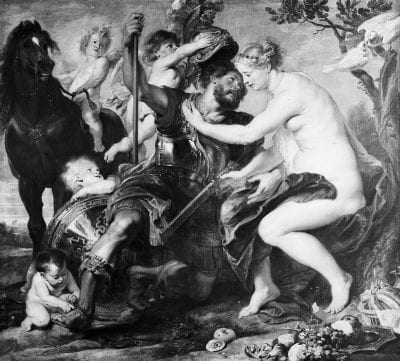
Given the sympathy with Orange taste of the 1630s and 1640s displayed in Louise Henriette’s palace, it would be logical to search for parallels with Lievens’s painting in the collections of Frederik Hendrik and Amalia. A now-lost allegory of peace by Peter Paul Rubens (fig. 7) likely served as a precedent for Lievens’s basic design.27 This large-scale picture, which hung above the mantel in Amalia’s private apartments at Paleis Noordeinde, possessed many of the compositional elements visible in Lievens’s painting: the proximity of the two gods’ faces and their interlocked gazes, the action of one god reaching across the torso of the other, the removal of Mars’s phallic weapon by Venus and his helmet by putti, and the coy manner in which Venus’s drapery conceals yet reveals her legs. The arched top of Lievens’s painting, a signal of its original function as a mantelpiece, strengthens this association. Lievens, who was patronized sporadically by the Orange family between ca. 1629 and 1650, would have known the earlier painting through firsthand observation, Louise Henriette’s description of it, or perhaps through a pen sketch by an artist in Rubens’s circle.28 Even the selection of Lievens–an artist who had returned from an eight-year stay in Antwerp strongly affected by the robust fleshiness, grand gestures, vibrant palette, and broad brushstrokes of Rubens’s work–must have been a conscious nod to the painting in the collection of the late Stadholder and his wife.
The selection of Rubens’s painting as a model and of Mars and Venus as a subject relates to the gods’ roles as lovers whose union engenders peace. Louise Henriette and Friedrich Wilhelm had been married in The Hague in 1646, and these mythological roles not only represent the most esteemed attributes of their respective genders, beauty and physical prowess, but also proclaim their romantic relationship as an allegory of marriage. A likely placement in the palace’s private chambers would have allowed the couple to mirror this intimate engagement behind closed doors.29 The narrative moment selected, the disarming of the war god in preparation for lovemaking, served to further shape their identities. Ancient authors like Hesiod (active 750–650 BCE), Lucretius (ca. 99–55 BCE), and Plutarch (ca. 45–120) described the bodily union of Venus and Mars as begetting harmony and bringing peace to the wider world,30 and the explicitly sexual references within the painting allude to the fundamental act that yields the reward of peace.
As rulers, Louise Henriette and her husband were particularly concerned with the quality of life in Brandenburg. Bützow had suffered a destructive fire in 1632, which had left only one quarter of the village’s residences standing,31 and the area had been so ravaged by the Thirty Years’ War that the Electress sought as early as 1651 to rejuvenate it through colonization by Dutch citizens and economic stimulation by Dutch enterprises. The village of Bützow demonstrated its gratitude by adopting the name “Oranienburg” in 1653. Louise Henriette went on to sponsor other public projects in the town, such as a new church tower and an orphanage.32 Similarly, Friedrich Wilhelm had repopulated parts of Brandenburg with Frisian citizens shortly after the Treaty of Westphalia, contributing to Brandenburg’s reputation as a land of opportunity.33 Lievens’s characterization of the royal couple as sowers of concord is thus historically grounded in their actions as rulers, and it means that the picture functions not only as a portrait historié and allegory of marriage but also as a potent allegory of peace.
Rubens’s painting not only provided a ready source for Lievens’s composition, but it is also indicative of the presence of paintings of large-scale female nudes at the court of Frederik Hendrik and Amalia. Palace inventories and documents list a number of pictures presumed to contain female nudes based on conventional treatments of the subjects. Among paintings recorded are themes like the freeing of Andromeda and the flight of Cloelia by artists who typically worked on a large scale, such as Cornelis van Haarlem (1562–1638), Pieter de Grebber (ca. 1600–ca. 1653), Paulus Bor (ca. 1601–1669), Willieboirts Bosschaert, and Rubens.34 The Oranjezaal was also peppered with large-format nudes, and even the Electress’s older brother had commissioned an “entirely naked” Venus from Dirck Bleker (ca. 1622–after 1672), who received a stunning 1,700 guilders for his likely life-size painting in 1650.35 This rise in the popularity of the female nude at the Orange court seems to correspond to a larger trend that also affected the Netherlands in the 1640s.36
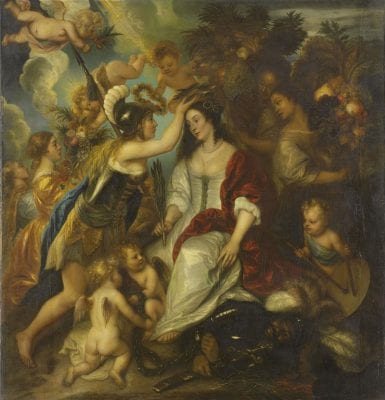
In her work on Honselaarsdijk, Rebecca Tucker has stressed the necessity of viewing the palace as an unified whole in terms of its architecture and decorative programs, and the application of this approach to Schloß Oranienburg offers a new understanding of Lievens’s painting. By framing the picture within the context of Louise Henriette’s adoption of the taste established by her parents in The Hague, the tension surrounding the nude representation of the Electress is eased. Furthermore, from the Aphrodite of Knidos (Roman copy, ca. 350–340 BCE; Musei Vaticani, Rome) by Praxiteles (active ca. 375–340 BCE) to Titian’s Venus with an Organist and Cupid (ca. 1555; Museo del Prado, Madrid), nudity has long functioned as an identifying attribute of Venus–comparable to Minerva’s armor or Jupiter’s thunderbolt–and should not be seen as an extension of Louise Henriette’s person but as an element of the role that she has donned, almost as a costume.37 It is fundamental to the inherently multiple functions of this painting as portrait historié and allegory of marriage and peace, for only through physical beauty can Venus seduce Mars and facilitate prosperity for mankind. The alteration of her hair color also tempers the portrait identification and provides some emotional distance between the viewer and the subject.38 The import of her nudity can be seen in a comparison between this painting and an allegory of peace by Lievens from one year earlier (fig. 8), where the female figure displays the dark hair, pronounced cheek bones, button lips, and elegant nose of Louise Henriette.39 While the Rijksmuseum painting conveys the bounty associated with peace, it contains no hint of the conjugal tenor of the 1653 painting, which is perhaps why the newly settled Electress may have refused it from Lievens as decoration for her palace.40 Louise Henriette’s intention to perpetuate the Orange taste for portrait historié just as the widow Amalia was promoting herself as the stabilizer of the Orange dynasty at the dawn of the First Stadholderless Period (1650–72) makes Lievens’s Mars and Venus even more powerful.41 The true freedom that Louise Henriette displays in Lievens’s painting is the control that she harnesses of her own self-image, fashioning herself as a female ruler possessing great agency in her new identity as Electress of Brandenburg, princess of Orange, and mistress of Oranienburg.
